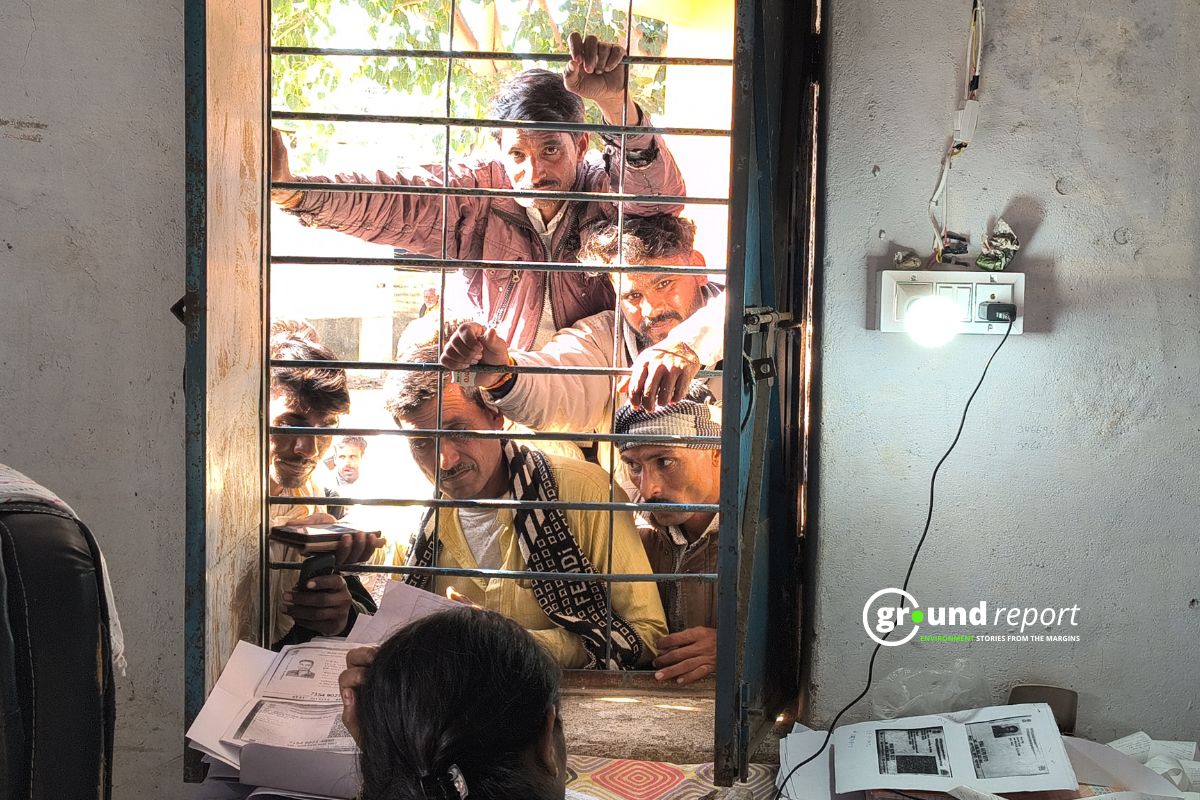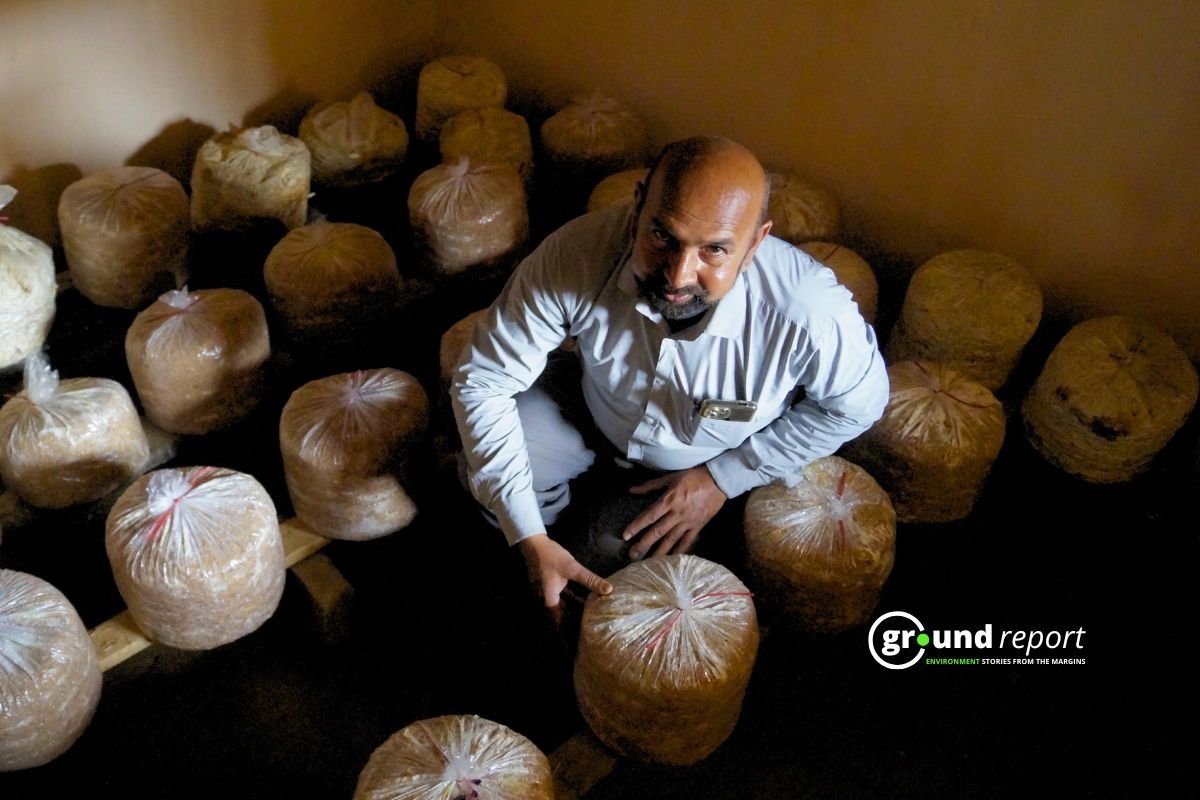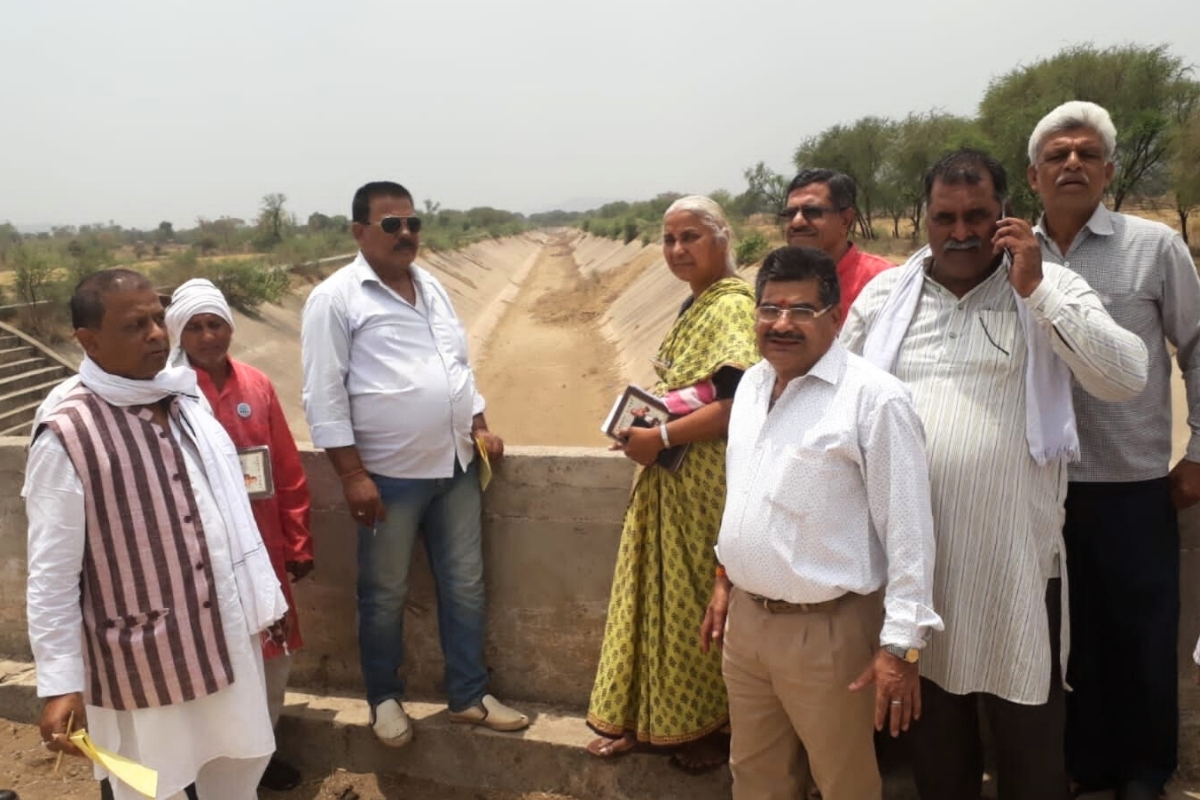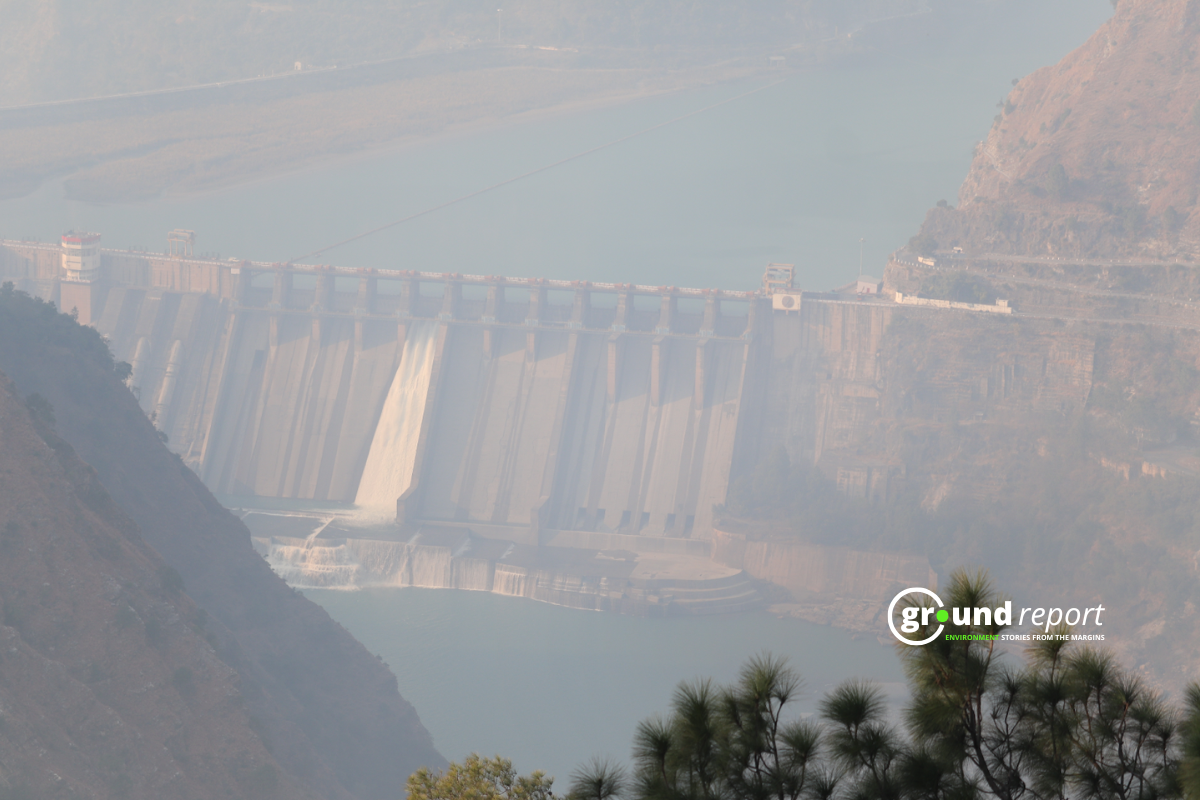The grasslands of Kharmor Sanctuary of Sardarpur tehsil of Dhar district of Madhya Pradesh once echoed with the dance of the Kharmor bird (Sypheotides indicus). The high jump of the male bird and the display of colourful feathers were a miracle of nature. In 1983, Sardarpur Sanctuary was created in 34812.177 hectares of government and private land to conserve the endangered Lesser Florican birds in their favourite habitat– dry grasslands.
But today, neither the flight of Kharmor is seen here, nor the earlier splendour in the grasslands. On the other hand, the rules of this sanctuary have kept the lives of thousands of villagers of 14 gram panchayats tied. But now there is hope of change in this situation. On March 18 this year, Forest Minister Dilip Ahirwar told the State Assembly,
“Sardarpur will be reorganized once the new sanctuary in Sagar is notified.”
A week ago, on April 11, the Madhya Pradesh government issued a notification for Dr. Bhimrao Ambedkar Sanctuary. This sanctuary, which falls within the boundaries of Sagar district, will be the 25th sanctuary of the state. It will be spread over 25,864 hectares.
Now, after the announcement of the new sanctuary, the reorganization of Sardarpur Sanctuary is considered certain. After the reorganization, the area of Sardarpur will be reduced by 21,528 hectares (215.28 sq km). It will now be limited to only 1682.203 hectares. The reduced area will be adjusted in Kuno National Park, Karmajhiri Sanctuary and Sagar’s new Dr. Bhimrao Ambedkar Sanctuary. This will free the residents of these 14 gram panchayats from the legal restrictions of the sanctuary.

The reorganization of Sardarpur Kharmor Sanctuary marks a turning point for conservation and community rights. Established to protect the critically endangered Kharmor bird, the sanctuary’s rigid regulations had for decades restricted the livelihoods of tribal villagers across 14 gram panchayats, limiting farming, land ownership, and development.
The downsizing effort focuses only on areas with active Kharmor presence, villagers stand to regain land rights and access to basic amenities, while conservation efforts are expected to become more focused and effective. Experts say the key to saving the Kharmor lies in restoring traditional grasslands and involving local communities—offering hope that a balance between ecology and development is finally within reach.
Rules restricting life, livelihood
The Sardarpur Kharmor Sanctuary in Madhya Pradesh was created in 1983 to protect the endangered Kharmor bird. But for villagers living in 14 nearby gram panchayats, the sanctuary has become a source of hardship.
People from the Bhil and Bhilala tribal communities live in villages like Gumanpura, Bimrod, Dhulet, and Songarh. They say government rules meant to protect wildlife have restricted their traditional way of life, making it hard to farm, build houses, or access forest resources. While the bird found safety, many villagers felt they were locked out of their land.
Due to legal obligations related to the sanctuary, even if the name of a villager is on the papers of the land of these villages, they do not have the right. Raju Patidar (44), a farmer of Dhulet village, says,
“Only our name is on our land, we cannot sell it nor give it to our children. Taking a loan from the bank is a far-fetched idea.”
Due to the sanctuary status, villagers in these areas are not allowed to open businesses or shops on their own land. Property transfer restrictions also make marriages difficult. With limited employment opportunities, many young people are migrating to cities in search of work.

With teary eyes, Raju shares, “Of our two daughters and one son, Arvind—the only son, he’s 22—left for the city last year looking for work. Now he’s settled there. Whenever we ask him to come back, he refuses.”
Sardarpur Sanctuary was notified under Section 18 (1) of the Wildlife Protection Act, 1972. Subsequently, under Section 20 of the Act, the sale, purchase, registration, and transfer of land in these villages was prohibited. After this, it seems as if development has come to a standstill here. The situation is such that for basic facilities like roads, electricity, schools, and water, permission of the Forest Department is required, which is hardly available.
Agriculture, which was the basis of livelihood of these villages, is also in trouble. Permission to dig new wells, install borewells, or level the land is also hardly available. Radha Bai (42) of Semlya village works as a field labourer. Talking about her difficulties she says,
“Farming has become difficult due to a lack of resources and water. This is increasing the cost.”
Radha further adds, “We cannot dig wells and tube wells on our own land as per our wish, for this also we need the permission of the forest department, since last year the process of digging wells is limited to papers.”
Another villager, Ambabai, shares her frustration: “Nilgai and wild boars constantly destroy our crops. When we complain to the forest department, they ask for photos and paperwork. Even after submitting everything, we still have to run from office to office just to get the compensation.”
Ambabai owns 8 bighas of farmland, where she is currently growing onions. Villagers like Amba say that the compensation they receive in such cases is far too little compared to the actual loss.

However, now the State Wildlife Board has passed a proposal to free these villages from the sanctuary, which was approved by the Central Government. Principal Chief Conservator of Forests (Wildlife) Shubhranjan Sen says,
“Now only forest land will be a part of the sanctuary, notification will be issued soon.”
In fact, the sanctuary will now be limited to only 1682.203 hectares. This will include the forest compartments of Panpura beat (P-423, P-422, P-437, P-438, P-439, P-445).
The Kharmore bird tragedy
The number of Kharmore birds across the country was 3500 till the year 2000. Due to its declining population, this bird has been placed in the critically endangered category in the Red List of the International Union for Conservation of Nature (IUCN). According to the research of the year 2020 by the Bombay Natural History Society (BNHS), only 340 male Kharmores are left across the country, while only 1000 Kharmores are left worldwide. Based on the assessment done by Bird Life International in the year 2021, it has been included in the category of critically endangered.
11 Kharmores were seen in the Sailana and Sardarpur sanctuaries of Madhya Pradesh in the year 2019, after which this number kept decreasing, and for the last two years it has become zero. Forest Minister Dilip Ahirwar, while answering a question in the budget session 2025 of the MP Legislative Assembly, said that the state government spent Rs 230.16 lakh on Kharmore conservation from 2020 to 2025.
But in the last 5 years, 17 Kharmore birds have been seen in Sardarpur in the state. At the same time, no bird was seen in Sailana in 5 years. While the maximum (Rs 172.86 lakh) has been spent on this sanctuary. Sardarpur social activist Akshay Bhandari says that seeing only 17 Kharmores even after spending lakhs of rupees in 5 years raises questions on the conservation strategy and transparency.
Wildlife Institute of India (WII) scientist Dr. Sutirtha Dutta believes that the lack of Kharmore is an indication that grasslands important from the point of view of biodiversity are rapidly disappearing in India.

The Forest Department is making efforts to protect the declining Kharmor bird population, but not all conservation measures have yielded results. Some initiatives have even raised questions about the misuse of public funds.
One such example is the ₹18 crore soundproof wall built along a 5.66-kilometre stretch between Dhulet and Siyawad on the Indore-Ahmedabad highway. The wall was meant to shield the Kharmor from traffic noise. However, a forest official, speaking on condition of anonymity, revealed that the bird hasn’t been spotted in that area for the past 10 years.
Reorganization: A new path?
Local people say that the reorganization of Sardarpur Sanctuary will have two major benefits. First, the railways will no longer face obstacles in laying the railway line. The railway projects of Dhar district will gain momentum. Secondly, the farmers will get economic freedom by removing the ban on the purchase and sale of land in 14 villages.
Shubhranjan Sen says, “Now only that area will remain a sanctuary where Kharmore is actually present. This will help in the conservation of Kharmore.” Sen further says, “The small area guarantees effective monitoring. Now we can keep an eye on the activities of Kharmore with drones and satellite imagery.”
Anandibai, a resident of Amodia village, is thrilled about the news of reorganization. “Now we can finally open a shop on our own land or even sell it if we need to. This feels like a new beginning for us,” she says with hope.

Thirty-year-old farmer Sohan Choyal from Amodiya village is the third generation of his family living under restrictions due to the Sardarpur Kharmor Sanctuary. He says,
“The Power Grid sub-station work began in 2004 and was completed in 2008. Land from 29 farmers was taken, but no compensation was given—nor were we offered land in return.”
Sohan is now waiting for the official notification of reorganization. He hopes that once it is issued, their village will start receiving basic facilities like other gram panchayats, and the path to getting compensation will finally open.
Farmer Bhanu Singh, 45, from the same village, shares the same frustration. “We’ve been hearing for years that we’ll be freed from the sanctuary’s rules and restrictions. But until we get the papers in our hands, we won’t believe it,” he says.

Way forward: Keeping the balance
The recent changes in Sardarpur Sanctuary have brought relief to the villagers and renewed hope for the return of the Kharmor bird. But the bigger question remains—can we strike a balance between people’s needs and protecting nature?
Ajay Gadikar, an environmentalist and member of the Wildlife Institute of India’s 2017 report on the Kharmor, says, “Once farmers from the 14 gram panchayats get their land back, they can become conservation partners. Community participation will be key.”
Kharmor birds prefer fields with traditional crops like jowar, moong, and urad, which grow to about 50-100 cm. This height helps them spot predators. During the breeding season, male birds perform impressive aerial displays to attract females.
Sujeet Narwade, a researcher at the Bombay Natural History Society (BNHS) and author of a study on the Lesser Florican in Rajasthan, agrees.
“Just because the birds haven’t been seen in Sardarpur for two years doesn’t mean they’ve given up on the area. If we restore the grasslands, they’ll return. But this is only possible with help from local communities,” he says.
He adds that farmers in Ajmer are already supporting conservation by growing traditional crops, showing that there is still hope. This could be the start of a new chapter, where the villagers thrive and the Kharmor returns to dance again. But it all depends on whether the Madhya Pradesh Forest Department can truly win the trust of the villagers and make them a part of the conservation journey.
Support us to keep independent environmental journalism alive in India.
Keep Reading
Taxpayer money flows while endangered Lesser Florican disappear
Madhya Pradesh cracks down on stubble burning: Can FIR, fines fix the problem?
Water burden on women: Health and education suffer in rural MP
Goodness of Guggal: Fights soil erosion, boosts farmer income
Follow Ground Report on X, Instagram and Facebook for environmental and underreported stories from the margins. Give us feedback on our email id greport2018@gmail.com.
Don’t forget to Subscribe to our weekly newsletter, Join our community on WhatsApp, and Follow our YouTube Channel







